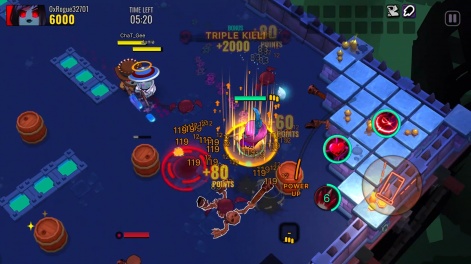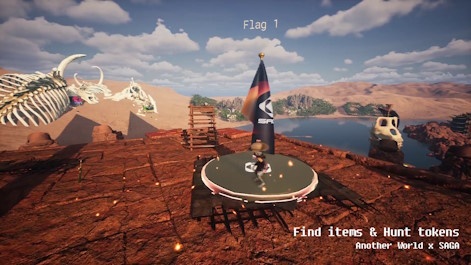Saga CEO Rebecca Liao on the launch of publishing division and mass market web3 | Pocket Gamer.biz

It’s been a big month for Saga. The web3 company announced Saga Origins, its publishing division, in late March, and today sees the launch of its mainnet. Many of the game projects already receiving support and airdrop campaigns on Saga’s platform are mobile titles.
Saga is an ecosystem for companies that want to build and publish in the web3 space. The company’s mission is to create an environment for studios to build experiences using blockchain, and it’s received investment from the likes of Samsung, Com2uS, and Polygon.
At GDC, Rebecca Liao, co-founder and CEO of Saga, talked about Saga Origins and its aim to publish “provocative, expansive, and boundary-pushing” experiences that other studios won’t touch.
The company also hopes to rally both traditional and web3 games companies behind its Saga Multiverse ecosystem, where creators and developers collaborate to build mobile titles connected by Saga’s own protocols.
With Saga Origins, the company becomes the first web3 chain to establish a dedicated game publishing arm. It’s a full-service plan to bring new web3 games to a global mass market. Whereas developers might traditionally secure publishing deals only to build and launch their games, Saga Origins offers promotional partnerships with influencers, sponsored user acquisition campaigns, tournaments with token giveaways, community building, and other long-term marketing support.
Liao mentions Saga’s blockchain mainnet in the video above, which is set to launch today following its successful test phase.
Mobile is the mass audience in gaming – a huge focus for our games portfolio
Rebecca Liao
During GDC last month, we sat down with Saga’s co-founder and CEO, Rebecca Liao. She joined PocketGamer.biz at a bustling café in San Francisco to discuss her philosophy and roadmap.
“Mobile is the mass audience in gaming,” she says, referring to the fact that many of the titles already playable in the Saga Multiverse are mobile games. “Given our emphasis on bringing the benefits of web3 in the most scalable way possible, it is a huge focus for our games portfolio.”
Saga has already been running regular promotional airdrop campaigns with games on their chain, and many recent participants are mobile games: Rogue Nation (which was playable at Saga’s GDC event), Love Monster, Bladerite, Gas Hero, Phantom Galaxies and Mega Weapon, for instance. Angelic is currently on PC but is scheduled to be released on mobile platforms in the future.
Why go to the effort to launch its own new publishing house at all? “Honestly, a lot of people are shocked that any layer-one chain would take on the effort to do this because being a publishing house is A Lot,” laughs Liao. “But we felt that the gamers deserved it. Because so far, blockchains have taken the perspective that it’s on the games to bring users to the chain. And so the games have had to undertake the effort of user acquisition, retention, all of that.”
In traditional mobile and console gaming, platforms and stores play a big role in discoverability. “It’s much more efficient for the platforms to do it,” continues Liao. “As a chain, we are the platform. We have the resources, scale, and reach. And therefore, we’re going to take on the responsibility of user acquisition, creating game awareness, fostering the community, and doing this across a portfolio.”
Samsung’s head of gaming looked at the team and noted that we have a very strong creative point of view
Rebecca Liao
She continues: “It’s still the case that anybody can build on Saga. It is a general-purpose layer infrastructure, so you can deploy your game anytime. But in terms of the titles that we actually back and take to market, those will go under Saga Origins.”
It’s clear Liao feels Saga is uniquely positioned to do this. It already had its Innovator Program and supported games on its chain with play-to-airdrop rewards. It seems they had a nudge in the right direction from developers and investor Samsung, making the shift feel natural.
“A few of the game-makers piped up, ‘Would you consider publishing this?’” Liao tells us. “I have to give a lot of credit to Samsung as well, which is one of our main investors. Their head of gaming said, ‘You have what it takes because you are the machinery for go-to-market for a lot of these games.’ He also looked at the team and noted that we have a very strong creative point of view. We like content that’s provocative and makes people think and feel deeply. The games we naturally gravitated towards, and the developers we spent time interacting with, were starting to congregate around a select few games. This is the beginning of a portfolio! So it all happened quite organically.”
Even before the publishing house was announced, Saga had some 340 products building on its platform (“80% of that is gaming, 10% is for pure NFT and the rest is DeFi”).
Will there be a specific type of Saga Origins game, mobile or otherwise?
The three words we use to set the criteria for any title we consider are provocative, expansive and uncompromising
Rebecca Liao
“The three words we use to set the criteria for any title we consider are provocative, expansive and uncompromising,” says Liao. “So we’ll work with the most difficult game developers out there, right?! But we love them dearly. Saturday morning, one called me and said, ‘I don’t think there’s enough blood in this.’ You know what, if you wake up in the morning, talk about blood, and still feel good? That’s your experience? Go for it! We’re all about creative freedom. So there is starting to emerge a very notable type of Saga Origins game, for sure.”
New games on the way from Saga Origins
The new games Saga Origins has signed will be revealed closer to Gamescom.
“I will say why we were attracted to the very first game we signed. We had never seen a web3 game like it before and frankly not a traditional game like it before, so that was unique,” says Liao, maintaining a sense of mystery about it at this stage. “Fundamentally, it’s a survival game, but there are elements of horror as well. There is a little bit of a cinematic TV show quality to it. It’s a very gritty depiction of American life. The first time that I saw a demo for it, I just had to have more. He showed me pages and pages of [gory] assets, and that’s why we decided to publish his game. That’s probably the first thing to look forward to: a survival horror game.
“And the second one is much more cinematic. It’s an MMORPG, which can be a very complicated category to work with. There are fantasy elements to it. It’s not so much the lore that people are interested in but the cinematic quality of it. Those are a few we’re working hard on, but we would like to find a few more before the year is done.”
Over the years, traditional gamers have expressed some resistance to blockchain games. There was a sense at GDC that web3 games might genuinely be getting better. One of the topics we discussed at Pocket Gamer Connects San Francisco, taking place during GDC week, was whether this is the year blockchain games see mainstream acceptance among traditional mobile gamers.
“During the bear [market], traditional gaming was solidly against web3 gaming, and that would be the thing that I would offer as the biggest challenge then,” says Liao. “But now I think it’s changing a bit, especially because the reality is traditional gaming is not doing as well right now. So they’re looking for new revenue opportunities. They’re never going to do anything that drives the gaming community away permanently, which, honestly, leaning into some of these highly speculative web games could. I think the big web2 publishers and studios are still wary about this space, but some of the [web3] games you’re seeing now are quality games. And I think we’re about to share something very new.
I give a lot of credit to the game developers because it’s difficult enough to build a great game without introducing anything new
Rebecca Liao
“The first time you saw web3 games, a lot of those were templated games; that’s the only way you can get to market that quickly. But a lot of the games that are coming to market now were in development all this time, and so they’ve taken the time to build something awesome. I give a lot of credit to the game developers because it’s difficult enough to build a great game without introducing anything new. But they have managed to create great experiences and actually incorporated the chain, the web3 element, in a meaningful way. I am excited, and I think that it’s going to get even better.”
User acquisition, retention and community
“We return to first principles a lot. How a community starts is incredibly important,” continues CEO Rebecca Liao, when it comes to building user communities for acquisition and retention. “It has to have a strong set of values and a personality to start, and that’s what you build a community around. In terms of engaging people and help them to stick around, yes, there are a set of mechanisms you can use with crypto to continuously engage users. But it starts with that set of values. All gamers are incredibly passionate people; they need to latch on to something they can believe in. They want friends that they can interact with, whether in real life or online. Communities tend to congregate, and types of UGC start to pop up; people start to interact with the game developer to give them ideas to feed back into the game. Every single time we hop into Discords for these games, the dopamine loop is pretty strong! And it’s amazing to see because all the connections are quite genuine.”
User acquisition is expensive, which is a significant factor in the success or failure of mobile games. Are things easier once you introduce a web3 element? “One thing is that web3 gaming is still small, to be honest,” says Liao. “It doesn’t take long for people to know about your game. But for your game to actually do well, it’s still an expensive proposition. I would say the thing about crypto is because the speculative nature of it is so prevalent, you probably need to work a little harder for that user retention because there’s always something else to move on to.”
Rebecca Liao draws our attention to how comparatively few gamers a web3 game needs in order to be considered a success, compared to the more mature mobile market. “Our aspiration at Saga has always been that we need to be competitive with wider gaming,” she tells us, remembering that “someone asked a top web3 game how many monthly active users [they had]. It was perhaps 50,000. In wider gaming, a game that only has 50,000 MAUs – unless everybody in there is a whale! – is generally considered a failure. Even a million MAUs would often not be considered a great launch! You really need to get to five to seven million users. So we have our work cut out for us.”
We are already starting to cross the divide. It’s about talking about the game experience and mechanics
Rebecca Liao
There are advantages to working in the blockchain space, though. Airdrops (giveaways) are common ways to incentivise the community, and Saga has noticed a flywheel effect of everybody associated with a game doing airdrops.
“We said we will airdrop Saga tokens to the leaderboards of these new games,” says Liao of their play-to-airdrop plan. “The games started to get accepted, and [the studio] said, ‘Well, we might have a token ourselves, or we have NFTs. So we will do our own airdrop as well.’ And then the streamers get on board and say, ‘Hey, we will airdrop to users.’ And then sometimes we have partner chains that these games are also building on. And they definitely want tokens or other prizes to giveaway. So it’s not just a single airdrop that the players are getting, it becomes double, triple, however many airdrops. There is a community aspect to this as well; the prizes start to pile on, the excitement starts to build. I see a lot of that dynamic, community-building aspect.”
While Saga will work with web3-specific influencers to promote games, they’ve also signed with artists’ agency William Morris Endeavor to meet traditional streamers, influencers and content creators, so flagship titles will be promoted on the biggest channels. “So we are already starting to cross the divide,” says Liao. “And it’s about not talking about the token or the NFTs or any nomenclature specific to crypto. It’s about talking about the game experience and mechanics.”
In addition to Saga Origins, Saga is launching its mainnet today. The Saga Mainnet enables developers to build for mass adoption, scaling their infrastructure while maintaining the user experience of a single application. This Phase One launch enables Netmarble’s web3 division MARBLEX to leverage Saga’s infrastructure and provides scaling infrastructure to the Com2uS chain.
You can read more about blockchain technology on our sibling site BlockchainGamer.biz.




